Gentle and snow-white calla are known to many, as they are fairly common indoor flowers. Probably many of the flowers at the flower beds, very similar to calla, but there were no idea that it was actually they are. After all, Calla can grow perfectly and in the open soil, while making any flowerbed or a plot is simply incredibly beautiful.
The birthplace of these delicate colors are the tropics, however, with proper care and care, they can be raised in their flower bed and admire the beauty of air and fabulous colors. In addition, blooming these colors is quite long.
In this article we will consider more details and describe the colors of Calla, and also learn about the most common types and varieties of garden calla. We will try to reveal the most important nuances of the agricultural machinery growing these colors in the open soil.
Features and description Calla
Calla flower is a perennial herbaceous plant that belongs to the family of aroid or arones. This plant has a few more names: Scientific - grinding, common man - Bolotnaya whiteflift. Contrary to the general opinion that Calla is a houseplant, in recent years, garden callas are increasingly popular, which perfectly feel in the open soil. The natural habitat of these exotic plants is the tropics and the territory of Africa. The birthplace of Plants of Calla South America and Africa, in whose territory Calla loves to grow on raw and wet places.
Calla is a close relative of the Bolotnaya Bellennik, whose name is often assigned a calla flower. The second name of this plant Zantenkiya, which he received thanks to the German scientist, Botany Kurt Shpregel. It was this botanist called Calla in honor of his best friend Giovanni Zaltenski, who was also Botany.
Sometimes a beautiful calla flower is called "wedding" for delicate white petals that resemble a bride wedding dress.
Calla Plant Description:
- Garden Calla is a perennial, blooming plant.
- In nature, you can allocate two main colors of Calla: rhizuy and tuber. Some see a mistake in this, but in fact, all hybrid callas have rhizome, and species - tubers. All these calila feels great in the open soil.
- The height of the stem plant of the calla can vary from 30 cm to 150 cm, depending on the specific flower variety.
- Plant leaves grow on vegetative shoots. They are single and rather large, in length can reach 14 cm, and in a width of 11 cm. On the shape of a cullah-shaped leaves with a smooth and shiny surface. Also are the decorative value of this plant.
- Call color pains of one height with leaves.
- Calla flowers are very unpleasured and located on a cylindrical cob, which is hidden behind a white sheet covering with a pointed top. This "bedspread" is usually all taken for the flower of the plant.
- Calla flowers themselves exude a very pleasant fragrance than that resembling the smell of vanilla.
- The color covered can be white at the beginning of flowering and green after pollination. There are also species with a yellow bedspread, red-pink, lilac-burgundy.
- Calla bloom begins in May and lasts for three months.
- A few weeks after the end of flowering on the cob, the fruits of the plants are formed, which resemble red small berries.
- One of the features of the plant Calla is its ability to dilute the carpet in the area, creating unique drawings on Earth.
- Calla use as a live barometer. On the covering sheet of plants before the rain, water droplets appear, resembling tears.
The most popular types and varieties of calla
All calla can be divided into rhizable and tuber. Kornevic can include all hybrid plants such as Calla Ethiopian. Calle Remuna and Eliott can be attributed to the tuber. All of them are grouped along these two categories on the structure of the root system.
There is also another division of these plants by groups. In total, there are eight species of this herbaceous perennial. However, Calla Ethiopian, Calla Remuna, Calla Eliota, Calla whiten, Calla Bolotnaya and others are considered the most popular. Let us consider in more detail the most popular and common types and varieties of Calla flower.
Calla Ethiopian
- It is a tall plant that can reach 100 cm and more.
- This type of plant is characterized by snow-white colors.
- The Ethiopian Calla applies to rhizomic plants whose roots are located underground. There are no bulbs in such colors.
- Leaves and flowers of this type of calla are preserved even during the rest of the plant.
- A very moisture-loving plant, which prefers to grow in the shade, along the banks of rivers, lakes and water bodies.
- The best period for active growth and flowering from May to September.
Popular varieties of Calla Ethiopian:
- Sort "Nicolai". A very high herbaceous plant that can reach a height of 150 cm. Leaves on long stiffs and flowers have the same length. The leaves have the shape of the boom, are attached on long stiffs, with a shiny and smooth dark green surface. Covered outside green in diameter reaches 12 cm.
- Sort "Pearls". It is a low grade plant Calla. In height, only 50 cm can be achieved. This type of plants can be easily grown in the open soil in pots.
- Grade "Schone Zweibruckerin". The average grade of calla, which in height can grow up to 1 m. The leaves are large enough, have a heart-shaped form. White bedspread, it has a greenish tint below, in diameter reaches 15 cm.
- Grade "Green Goddess". Also, the average grade, which in height can grow 90 cm. Differs in bright green colors.
Calla remanna
- This type of calla is distinguished by low growth. The maximum plant can grow by 70 cm.
- The underground part of this flower is a tuber.
- Leaves are oblong, dark green, long can reach 30 cm.
- The bedspread is distinguished by a bright reddish-pink or reddish-burgundy bedspread.
- The plant of this species in the period of rest relieves the leaves. It usually comes in winter, and new leaves and flowers appear in the spring of Calla.
- Prefers to grow on dry areas.
Popular varieties of Calla remanna:
- Grade "Chameleon". This is a low calley grade, which can be grown without problems both in pots and in the open soil. It features a beautiful coloring bedspread: a gentle peach color with golden shades.
- Grade "Evening". This calla is distinguished by a rather extravagant coloring bedspread: a rich black and purple shade. The surface of the petal satin.
- Grade "Indian Summer". The covers of this Calla variety has a reddish-garnet tint.
Calla Elliota
- The lowest view of calla, which can grow up to 50 cm.
- The underground part of the plant is a tuber.
- Elliot Calla leaves are quite large, heart-shaped, dark green in white clock.
- Leaves are attached on long stiffs.
- The color of the bedspread inside is yellow, and outside - yellowish-green. In diameter can reach 15 cm.
- Prefers to grow at open solar places with the possibility of half the day in the hottest periods of the day.
Popular varieties of Calla Ellioto:
- Sort "Yellow corner". This Calla variety is distinguished by bright yellow flowers and green leaves of large sizes in yellow clock.
- Grade "Chernobiaya Beauty". The outer part of the bedspread has a gentle cream color with a light lemon tint, the leaves are large and spotted.
In addition to the above, Calla species can be noted Calla whitening, Calla Joyful, Calla Powerful. However, in the territory of Russia and other CIS countries, these types of Call are rarely grown.
Methods of breeding Calla
It is not difficult to divorce Calla on my own plot, the main thing is to choose the most convenient way for you. Calla can multiply in several ways. It is a seed reproduction and vegetative, to which the reproduction of tubers and the division of the bush or rhizoma. Consider all the ways in more detail so that you can decide which which suits you.
Seed reproduction of Calla
- Most often this method is used in breeding work to excrete new plants. However, you can try to grow Calla from seed yourself.
- The first step for you will get seeds. To do this, choose one strong plant and leave the pillage on it. After moving the leaves of the plant, the pillage begins to ripen what his strong jourver says. The pillage must be carefully cut and disassembled the segments within which the seeds are located.
- Further, all seeds need to be soaked in a growth biostimulator solution, for example, a solution of potassium humate. Seeds should be in a solution of approximately 5-6 hours.
- After that, you need to grow by germination of Calla seeds. To do this, place the seeds on the wet napkin and cover them also with a wet cloth. It is necessary to put them in a warm place for about a week. During this period, it is necessary to periodically moisten the seeds.
- Next, you need to prepare a container with a suitable substrate, which should consist of leaf land and sand.
- The substrate seeds seeds and keep them in the warm room before shooting.
- When seedlings are strengthened, they can be planted in an open ground.
Reproduction of rhizome division
- This method is suitable for calla, in which the underground part is rhizome. Most often it is the variety of Calla Ethiopian.
- The reproduction of the root division is best to carry out in the fall.
- To do this, it is necessary to gently separate the root neck of the plant from all the root. At the same time, watch the roots remain as much as possible.
- After that, all root cakes are placed in a spacious container. Which must be put in a dark room with high humidity and air temperature of 15 degrees.
- For the winter on the roots appear roots.
- In the late spring or early summer, planting material can be prepared for landing in an open ground.
Team breeding
- Calla tubers can be purchased in specialized stores, and can be obtained independently. If you have a calla flower already growing on the site.
- Before planting tubers, you need to carefully clean and treat with a weak solution of manganese.
- After that, the entire seating should be subjected to stratification. For this tuber, put in a cool place with a temperature of 5 degrees. You can use a vegetable chamber in the refrigerator.
- During this period, the tubers need to be tired and sometimes turn over.
- To plant tubers need to immediately in open ground. Optimal time for this is May.
- Prepare the boarding holes and land in them with a tubercle up.
- With this way, remember that Calla bloom significantly later.
- There is another variant of the reproduction of Calla with tubers. For this, they are planted in pots.
- This method of reproduction is best carried out in April.
- Tubers need to land in the prepared pots.
- After this capacity, it is necessary to contain at a temperature not lower than 20 degrees, while you need to follow so that the tubers do not swell.
- Spring tubers begin in the end of spring, and in June they are planted into open ground to a depth of 12 cm.
- With this method, Calla will bloom much earlier.
Stages of preparation before planting Calla
Landing and caulla care is not much difficult, however, to obtain a healthy and beautiful blooming plant, it is necessary to make a slight effort in preparing for landing. It is important to purchase high-quality and healthy planting material, as well as find on its site an ideal place for landing exotic beauties.
Stage 2. Selection of planting material
- The planting material is best acquired by those varieties that are successfully acclimatized in the conditions of your area. In order not to make a mistake with the choice, you can consult in specialized stores.
- You can purchase landing material in the form of tubers. In this case, carefully inspect them for damage or signs of disease. Tubers must be strong and elastic, with alive top tubers. Such a landing material is significantly cheaper than ready-made seedlings.
- In specialized stores and nurseries you can buy ready-made seedlings in containers that are immediately planted in an open ground.
- Do not acquire Calla seedlings or her tubers in the spontaneous markets or from strangers.
- Also remember that drawn flowers on labels in real life will be different. You are unlikely to get such a bright and rich color, moreover, after pollination covered almost all varieties become green.
- Pick Calla seedlings based on the planned composition, since these plants differ from the height of the leaves and the shade of colors.
Stage 2. Selection of Places for Landing
Callas in nature grow on wet soils of tropical forests, so the site also needs to create the necessary conditions for the growth of this plant. The optimal place for the growth of calla will be a plot near small water bodies, ponds or lakes, where the soil moisture is increased. If you do not have on the plot of artificial reservoir, you can choose a place in the garden. Watch that the site is not very shaded, otherwise Calla will lose coloring bedspread.
The choice of place also depends on the composition you have made. These flowers look perfectly near other blooming plants on the flower beds, as well as in single landings. Putting several Calla plants together, you can get a carpet from these plants.
Stage 3. Choice and soil preparation
Callas prefer to grow on fertile and nutrient soils, well moisturized. Consider that on the basis, where a very high content of organic substances, Calla can grow slowly. Since this is an exotic plant, on our soils of Calla can be very slow. Therefore, it is best to purchase a special mixture in stores. The best substrate for the growth of Calla should consist of a delicate land, leaf land, sand and peat.
Before planting plants, you must definitely switch the selected area. making it easy and breathable.
TECHNOLOGY PLAYING CALL IN OPEN PORT
- The best time for landing Call to open ground is spring, and more specifically the beginning of May. It is at this time that the threat of the last frosts, which can harm the plant.
- At the selected area, you need to dig up small landing wells, the size of which should be 5-10 cm in depth.
- If you land in the open soil of the clubs of the plant, then pre-need them to subjected to stimulating and processing growth stimulant.
- When landing in an open soil, Calla seedlings are also desirable to harden during the week.
- On the bottom of the landing well can be placed a little drainage to prevent stagnation of water from the roots. Small stones can be used as a drainage.
- Calla tubers need to disembark up.
- When disembarking ready-made seedlings, they must be carefully removed from the pots, trying not to damage the roots. After all, the root Calla system is very fragile.
- If you sit down several plants nearby, then the distance between them should be about 30-40 cm.
- Mineral fertilizers can be used, about 30 grams per square meter. In this case, throughout the entire period of growth, it is no longer necessary to feed the plant.
- Next, planting material is placed in the landing fumes and the soil is satisted. It is not necessary to compact the soil.
- You need planted tubers only after the appearance of the first leaves, and the seedlings can be poured immediately after landing.
Agrotechnics of cultivation of Call: Secrets and nuances of care
Calla care is not so complicated as it may seem at first glance. Even with the fact that this is a tropical plant, with attentive care, the flower will delight you with great blossom.
Watering Calla
Immediately after landing, Calla's clubs to open soil no need to water. It can be a little moisten the soil only two weeks later. Only so the plant will be able to correctly form the root system. At the same time, it is necessary to water carefully. The main thing is that the water does not get on the tuber of the plant. Next, the plant is regularly poured only after the appearance of several leaves. Watering is needed moderate, about once a week. In the most arid periods of summer, watering can be increased.
Loosening
After irrigations, the plant needs constant soil looser. Only so you can provide ease and breathability of the soil, which is very necessary for the active growth of the plant. You need to loosen neatly, trying not to damage the plant. Many gardeners are recommended for natural soil looser use worms.
Undercalinking plants
Calla also needs feeding, which stimulate the active growth of foliage and floweros. You can make fertilizers during plant landing in the amount of 30 g of mineral fertilizers per square meter. However, the further active growth of Calla will depend on the nutrients contained in the soil. 2-3 weeks after landing, each Calla bush can be fertilized by special fertilizers for tuber plants. During flowering, potash fertilizers can be added. Fertilizers containing nitrogen is better reduced, as they contribute to building foliage, and not growth of floweros.
Also once a month, it is possible to shed the soil around the callers with water and citric acid, since this plant loves the weakness of the sooth.
Fighting diseases and pests
A distinctive feature of Call is its excellent resistance to the emergence of various diseases. This plant is also not particularly interested in pests.
Digging and storage of tubers in winter
- Before the onset of frosts, it is necessary to neatly dig all the plant entirely, trying not to damage the roots.
- Next, neatly smooth the roots and rinse them with water. After that, all plants need to be placed in a well-ventilated room.
- After the plant serves, it is necessary to remove the leaves and cut the roots.
- On the tubers there are kids that need to be left until spring. For the winter months, they will have time to grow and can be used to land.
- The tubers necessarily need to be treated with a solution of manganese.
- After that, the tubers need to dry and place in a paper storage package. Keep calla tubers fashionable in a container for vegetables in the refrigerator.
- If you appear any damage on the tubers, they need to cut and cut the cutting place to be cut into green.
Using Calla in Landscape Design
- Callas are able to grow, creating a beautiful carpet. Therefore, they are perfect for creating unusual garden compositions.
- These flowers can also be planted along the garden tracks or as a framing for flower.
- Callas are suitable for solitary landing, especially tall grades of this plant.
- Since this is the moisture-loving plants, an excellent place for them will be the zone near the reservoirs.
Stock Foto Calla flowers in landscape design
It is possible to see more clearly to see all the beauty of calila colors in landscape design on the proposed photos.
Calla is amazing tropical plants that feel great not only at home, but also in the open ground. At the same time, the care of these plants is minimal. Therefore, it is not necessary to be afraid to try to grow such an exotic flower on its plot. After all, in the end, you will get a bright decoration of your garden.

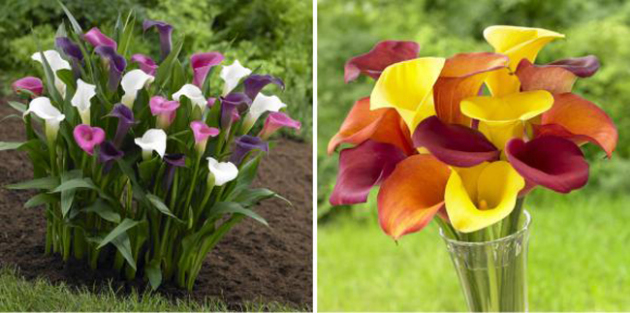
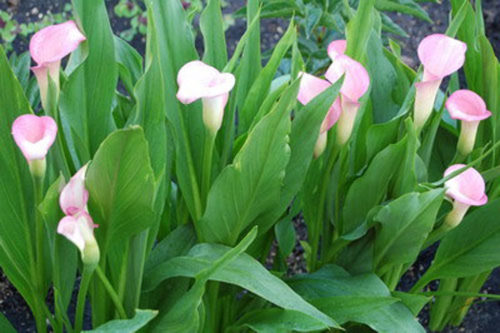
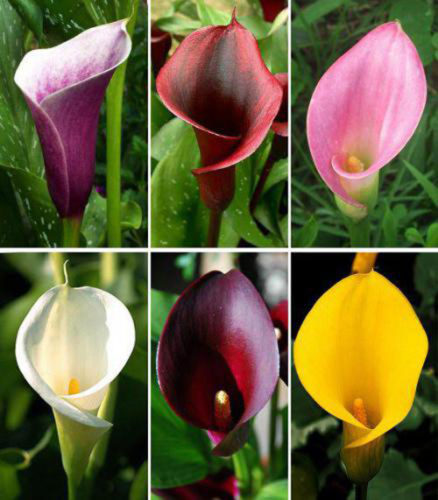
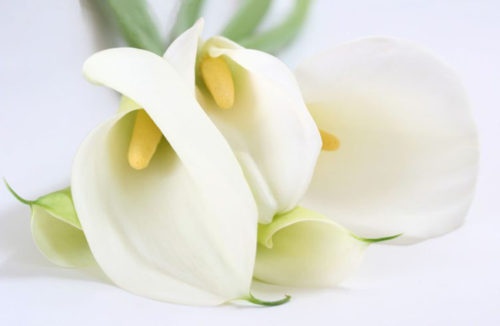
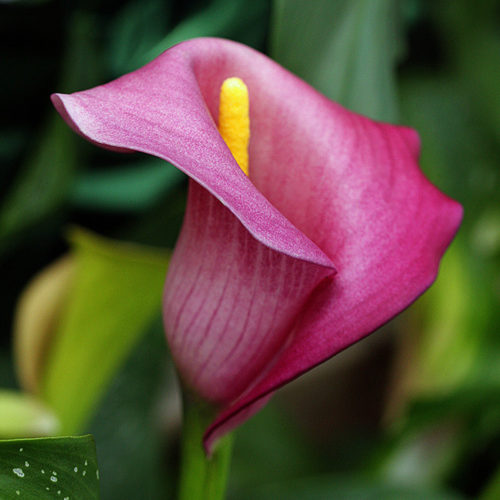
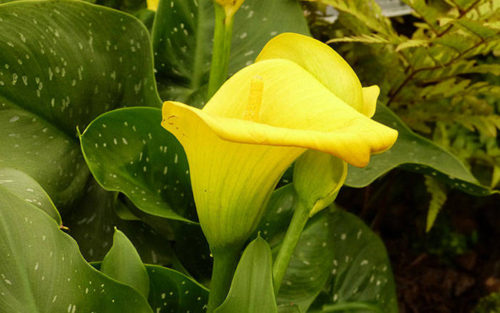

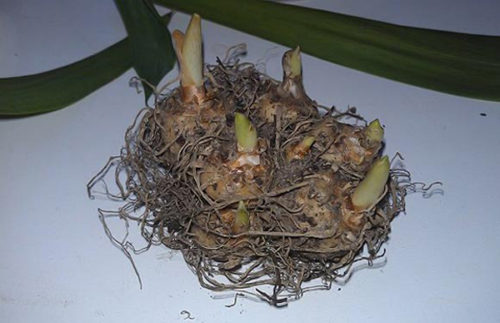
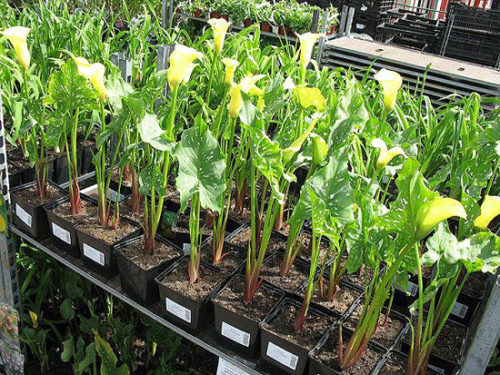
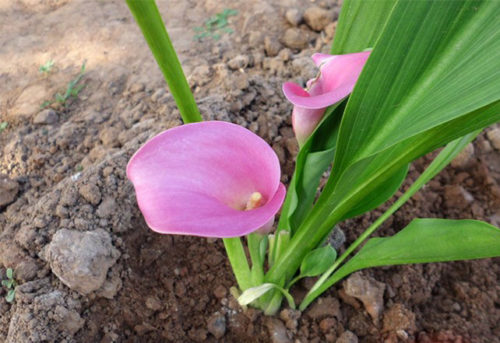
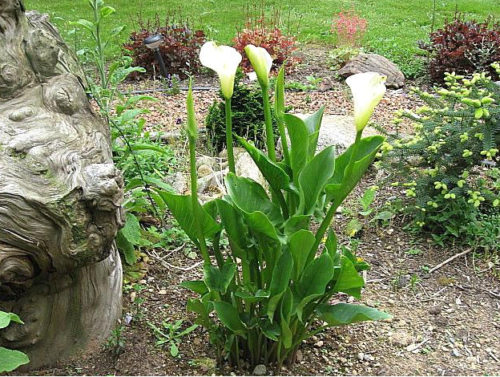
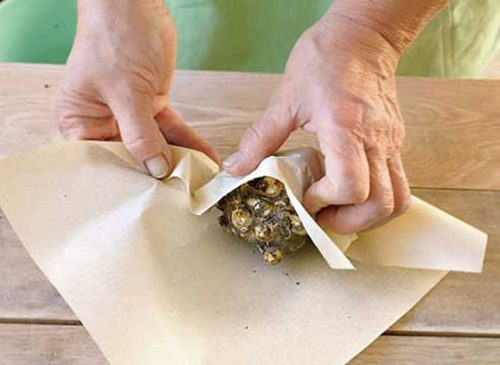
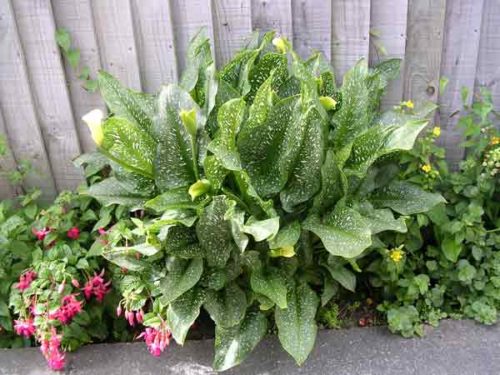
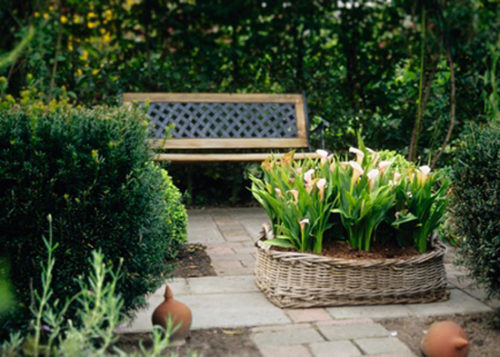
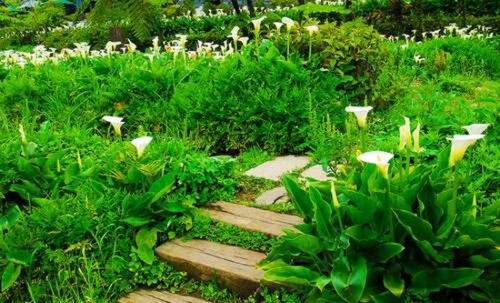
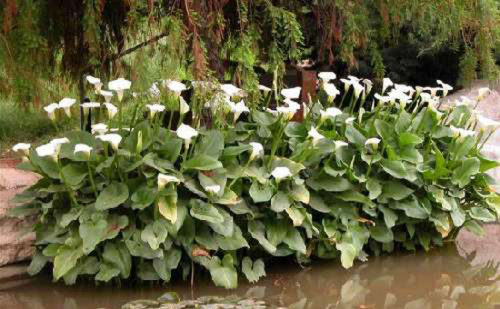












 Start a discussion ...
Start a discussion ...